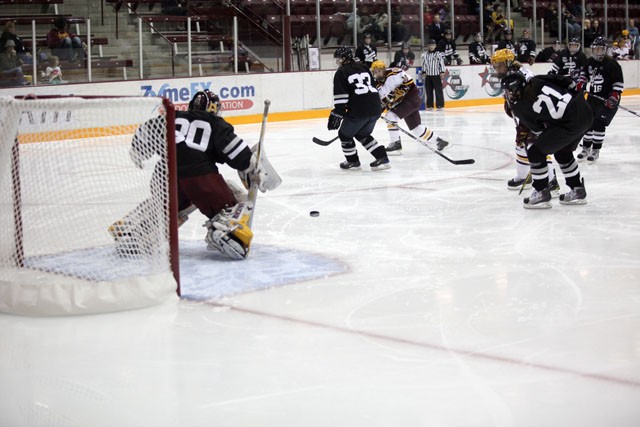The Minnesota Whitecaps are always at a bit of a disadvantage when they play top-tier college teams like the Gophers. After all, Gophers hockey players typically donâÄôt have to drive straight from a nine-to-five job to a 6:00 p.m. game, wondering if theyâÄôll have time to warm up.
Most of the Whitecaps do.
Though they are a professional-quality team with some of the worldâÄôs top womenâÄôs hockey talent, players do not get paid. In fact, they have to pay to play âÄî $1,000 a year to cover travel and other expenses.
So most players have full-time jobs and use much of their vacation time travelling to games throughout Canada. They also buy their own equipment.
âÄúItâÄôs tough,âÄù Whitecaps goalie Kim Hanlon, a former Gophers player, said. âÄúWe work all day and then we have to travel all over the country and in Canada to play.âÄù
Despite that, they skated the Gophers to an entertaining exhibition Friday night, taking a 2-1 lead into the third period but losing 3-2 on a pair of late Gophers goals. Hanlon got no sympathy from her former team, facing a barrage of 40 shots, while Whitecaps goals came from University of Minnesota-Duluth alumni, Allie Thunstrom and Saara Tuominen.

The Whitecaps play in the Western WomenâÄôs Hockey League (WWHL), one of two pro-like womenâÄôs leagues based in Canada, along with the Canadian WomenâÄôs Hockey League (CWHL). Each league contains one American team and four from Canada.
The winner of the WWHL plays the winner of the CWHL for the Clarkson Cup, which the Whitecaps won last year, becoming the first American team to do so.
Nine former Gophers currently play for the Whitecaps, including 2010 Olympic silver medalist Gigi Marvin and Krissy Wendell-Pohl, who ranks second all time in career points for the Gophers.
The Whitecaps are loaded with Division I and USA national team veterans, but unlike in their college years, the players now must make significant financial and life sacrifices to sustain their team and play the game they love at a competitive level.
The Whitecaps do not have a home rink, and so must reach out to Minnesota youth hockey programs that can either afford to buy ice time at rinks suitable for Whitecaps home games or have had that ice time donated to them.
In exchange, the Whitecaps use part of that ice time to put on clinics for the youth players, who receive free tickets to the games and whose hockey associations receive 100 percent of the proceeds from ticket sales. Some programs have raised more than $1,500 in a single night from the arrangement.
âÄúI donâÄôt know of any team, Canadian or American, that does more as far as working with the young players,âÄù head coach Jack Brodt said.
Though beneficial to youth hockey associations, the teamâÄôs lack of a home rink makes it difficult to cultivate a loyal home fanbase.
âÄúBecause weâÄôll go from Andover to Rochester to Rosemount to Chaska,âÄù team spokeswoman Kristie Minkoff said, âÄúmany people that are up in Chisago Lakes, letâÄôs say, wonâÄôt go down to the game [in] Chaska.âÄù
Though several rinks have approached the team about permanent residency, Minkoff said the teamâÄôs shoestring budget forces them to keep costs down by staying on the move.âÄù
The teamâÄôs 2008 budget totaled around $81,000, three-fourths of which went toward travelling costs for the teamâÄôs games in Canada. The playersâÄô annual fees help with those costs but donâÄôt cover them, and itâÄôs an unlikely person picking up the slack.
Brodt, the head coach.
âÄúItâÄôs a losing situation as far as [money] is concerned,âÄù he said. âÄúSo weâÄôre just hopeful that we can find enough sponsors and enough people to be interested to help us out to continue the program.âÄù
Now in their seventh year, the Whitecaps also rely solely on volunteers to train, treat, market and coach the players. Equipment discounts, a recent sponsorship deal with Degree For Women deodorant and a few free advertising opportunities are about the only other lifelines offered to this fledgling team of some of the worldâÄôs best female hockey players.
More Whitecaps players hail from the University of Minnesota than from any other school, making exhibitions against the Gophers at Ridder an especially meaningful experience.
âÄú[Playing at Ridder] was weird, especially being 32 years old,âÄù Winny Brodt-Brown, who helped win the GophersâÄô first national championship in 2000 and whose dad coaches the Whitecaps, said. âÄúThe last time I played in here was in âÄô03, so itâÄôs been awhile.âÄù
Hanlon said she and her teammates show Minnesota youth players that, âÄúno matter what level you play at, you can play for as long as you want. You donâÄôt have to go to college to keep playing. You can play anywhere.âÄù
This may prove even more accurate in the near future.
The NHL confirmed in August that it has been in preliminary talks with womenâÄôs hockey officials about developing a womenâÄôs professional hockey league which would pay players.
âÄúI think itâÄôs a possibility,âÄù Brodt-Brown said of the proposed league. âÄúI mean, when I started playing hockey I was playing boys hockey and I never thought there would be an opportunity to be a Golden Gopher.âÄù
Brodt said that Whitecaps like University of Minnesota-Duluth alumnus Jenny Potter were âÄúpioneersâÄù in womenâÄôs hockey at the high school and college levels and that a logical next step would be for them to blaze a trail for womenâÄôs hockey at the professional level.



